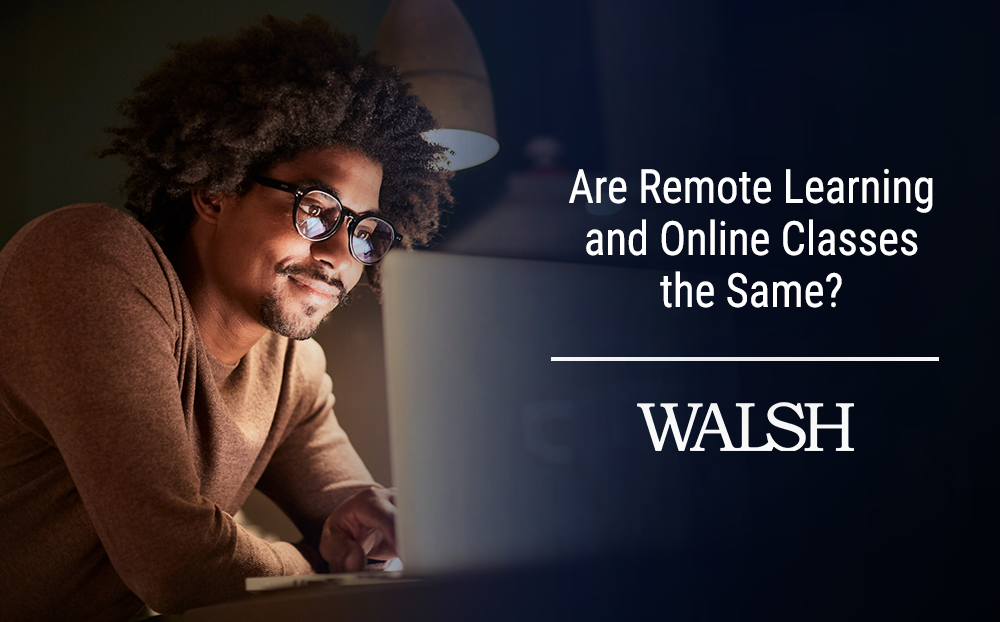Are Remote Learning and Online Classes the Same?
As the world changes and flexible education options become more important, many schools are offering remote course delivery. For maximum flexibility, Walsh’s attendance options include 100% online, in person, in a remote synchronous mode in connected classroom settings or a combination. So, what does “remote” mean? Many students may immediately think of an online course format, however, remote learning doesn’t necessarily follow the same structure.
Is remote learning the same as online classes?
Online programs are designed for students who need a flexible and self-paced education. The curriculum is generally taught using a combination of various content styles – PowerPoint presentations, discussion forums, written lectures, or scholarly articles – and is practiced through projects and online exams.
Remote learning may feature some of the same content styles as online classes, but could also incorporate a number of other instructional methods. While most courses will follow a unique structure that fits best with the curriculum and professor’s teaching style, remote learning may be delivered synchronously or asynchronously.
- Synchronous course delivery means that the professor and students are engaging during a specified time frame through a virtual meeting, discussion forum, or conference call. For example, a remote course may replace several online quizzes with Zoom meetings where students can discuss relevant topics and hear real-world examples of how concepts are applied in the industry. Dynamic connected classrooms let faculty, in-person, and remote students interact seamlessly in real time. All Walsh students receive a Zoom Pro account once enrolled in classes.
- Asynchronous course delivery includes any content not viewed in real time. Walsh courses regularly use asynchronous delivery through videos to walk students through difficult problems or narrated PowerPoint presentations to explain key concepts.
What are the benefits for students?
With remote learning, students can attend class and participate from anywhere in the world. There is no difference between Walsh’s internationally and nationally ranked online programs and those delivered remotely, on ground, or in any combination. Students receive the same curriculum from faculty with decades of real-world experience, in a way that fits their individual needs. A familiar environment may also help students feel more comfortable and be more productive.
“It has been great taking my final exams remotely,” said Axel Koblavi, a Master of Business Administration student. “It’s less pressure on me and allows me to focus more on the task at hand.”
As the world becomes more digital, remote learning also helps students acclimate to tools and technology being used in business today. Plus, who doesn’t mind cutting down on some money and time spent on a daily commute?
How can I get the most out of remote learning?
It may take some trial and error to adjust to remote learning, but here are some useful tips to help manage time, keep track of important dates, and finish courses successfully.
- Stay organized – Whether you prefer daily planners, to-do lists, or phone calendar reminders, it is important to stay as organized as possible. Refer to your course syllabus and Moodle dashboard to keep track of due dates, weekly tasks, and any changes that may occur.
- Find a designated space for school – Even though remote learning can take place anywhere, it is important to find a space that is comfortable and can function as your remote “classroom”. This could be a dining table, kitchen counter, or even a folding table in front of a favorite chair. A designated space for school helps you maintain consistency and stick to a routine.
- Take advantage of the Walsh Navigate app – Walsh Navigate offers many useful features to keep students connected and informed. Schedule an appointment with your academic advisor and use features like Study Buddies to form study groups with peers, Class Schedule to view meeting times, or Resources to find student services like tutoring.
- Keep in contact with faculty – Since many courses follow a unique structure and meeting schedule, it’s best to communicate with your faculty regarding any specific questions you have about your courses.
Just like online courses, remote learning is simply an additional delivery format. Students gain the same business and technology knowledge, sought-after skills, and opportunities for networking as an online, on ground, or hybrid format degree program.







